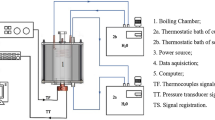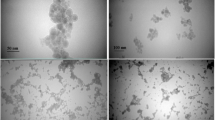Abstract
This study focuses on the effect of the nanostructured heating surface on the heat transfer coefficient (HTC) considering the nanofluid concentration used for coating surfaces and the heating surface morphology. Copper blocks with roughness values of Ra = 0.05 μm (smooth surface) and Ra = 0.23 μm (rough surface) were used as heating surfaces, and deionized water (DI-water) at atmospheric pressure and saturation temperature was used as the working fluid. Nanostructured surfaces were obtained by boiling process of Al2O3–DI-water-based nanofluid for different volumetric concentrations 0.0007 vol% and 0.007 vol% (corresponding to low and high nanofluid concentration, respectively) to analyze the interaction between the heating surface and the working fluid. With this purpose, six different copper surfaces were submitted to metallographic, roughness, wettability, and thermal image analysis. The experimental results showed that the enhancement or deterioration of boiling heat transfer is strongly affected by the nanofluid concentration—used to nanocoat the heating surface—and the original heating surface morphology. The nanocoating process increases the surface roughness and changes the surface wettability. Moreover, as the nanofluid concentration increases, the wettability and nanolayer thickness also increase. The wall temperature distribution, obtained by thermal image analysis, agrees with the HTC behavior. For the coated rough surfaces, it is observed deterioration of the HTC regardless of nanofluid concentration. The increase in the surface temperature and the consequent degradation of the HTC are more pronounced for higher nanoparticle concentrations.







Similar content being viewed by others
Abbreviations
- CHF:
-
Critical heat flux
- SEM:
-
Scanning electron microscopy
- HTC:
-
Heat transfer coefficient
- SS:
-
Smooth surface
- RS:
-
Rough surface
- h :
-
Heat transfer coefficient (kW/m2 K)
- L :
-
Distance between thermocouples (m)
- p atm :
-
Atmospheric pressure (kPa)
- q″:
-
Heat flux (kW/m2)
- R a :
-
Average surface roughness (μm)
- T i :
-
Thermocouples temperature at positions 1, 2, and 3 (K)
- T sat :
-
Saturation temperature of the fluid (K)
- T w :
-
Surface temperature (K)
- u :
-
Uncertainty (–)
- z i :
-
Distance of thermocouples from heating surface (m)
- ΔT :
-
Difference in temperature (K)
- θ :
-
Static contact angle (°)
- 1:
-
Location of thermocouple 1
- 2:
-
Location of thermocouple 2
- 3:
-
Location of thermocouple 3
- w:
-
Surface wall
References
Moita AS, Teodori E, Moreira ALN (2015) Influence of surface topography in the boiling mechanisms. Int J Heat Fluid Flow 52:50–63
O’Hanley H, Coyle C, Buongiorno J, McKrell T, Hu L-W, Rubner M, Cohen R (2013) Separate effects of surface roughness, wettability, and porosity on the boiling critical heat flux. Appl Phys Lett 103:024102-1
Forrest E, Williamson E, Buongiorno J, Hu L, Rubner M, Cohen R (2010) Augmentation of nucleate boiling heat transfer and critical heat flux using nanoparticle thin-film coatings. Int J Heat Mass Transf 1–3:58–67
Heitich LV, Passos JC, Cardoso EM, Da Silva MF, Klein AN (2014) Nucleate boiling of water using nanostructured surface. J Braz Soc Mech Sci Eng 36:181–192
Narayan GP, Anoop KB, Das SK (2007) Mechanism of enhancement/deterioration of boiling heat transfer using stable nanoparticle suspensions over vertical tubes. J Appl Phys 102:074317
Souza RR, Passos JC, Cardoso EM (2014) Influence of nanoparticle size and gap size on nucleate boiling using HFE7100. Exp Therm Fluid Sci 59:195–201
Park SD, Moon SB, Bang IC (2014) Effects of thickness of boiling-induced nanoparticle deposition on the saturation of critical heat flux enhancement. Int J Heat Mass Transf 78:506–514
Zhao Z, Zhang J, Jia D, Zhao K, Zhang X, Jiang P (2017) Thermal performance analysis of pool boiling on an enhanced surface modified by the combination of microstructures and wetting properties. Appl Therm Eng 117:417–426
Li YY, Liu ZH, Zheng BC (2015) Experimental study on the saturated pool boiling heat transfer on nano-scale modification surface. Int J Heat Mass Transf 84:550–561
Kiyomura IS, Manetti LL, da Cunha AP, Ribatski G, Cardoso EM (2017) An analysis of the effects of nanoparticles deposition on characteristics of the heating surface and ON pool boiling of water. Int J Heat Mass Transf 106:666–674
Dong L, Quan X, Cheng P (2014) An experimental investigation of enhanced pool boiling heat transfer from surfaces with micro/nano-structures. Int J Heat Mass Transf 71:189–196
Das S, Kumar DS, Bhaumik S (2016) Experimental study of nucleate pool boiling heat transfer of water on silicon oxide nanoparticle coated copper heating surface. Appl Therm Eng 96:555–567
Sarafraz MM, Hormozi F, Peyghambarzadeh SM (2016) Pool boiling heat transfer to aqueous alumina nano-fluids on the plain and concentric circular micro-structured (CCM) surfaces. Exp Therm Fluid Sci 72:125–139
Phan HT, Caney N, Marty P, Colasson S, Gavillet J (2009) How does surface wettability influence nucleate boiling? C. R. Mecanique 337:251–259
Salimpour MR, Abdollahi A, Afrand M (2017) An experimental study on deposited surfaces due to nanofluid pool boiling: comparison between rough and smooth surfaces. Exp Therm Fluid Sci. https://doi.org/10.1016/j.expthermflusci.2017.06.007
Teodori, E, Pontes P, Moita AS, Moreira ALN, Georgoulas A, Marengo M (2017) Experimental and numerical study on sensible heat transfer at droplet/wall interactions. In: ILASS–Europe 2017, 28th conference on liquid atomization and spray systems, 6–8 September 2017, Valencia
Yang SR, Kim RH (1988) A mathematical-model of the pool boiling nucleation site density in terms of the surface characteristics. Int J Heat Mass Transf 31:1127–1135
Kang M-G (2000) Effect of surface roughness on pool boiling heat transfer. Int J Heat Mass Transf 43:4073–4085
Luke A (2003) Thermo and fluid dynamics in boiling, connection between surface roughness, bubble formation and heat transfer. In: 5th international boiling heat transfer conference, Montego Bay, Jamaica, 4–8 May 2003
Jones BJ, McHale JP, Garimella S (2009) The influence of surface roughness on nucleate pool boiling heat transfer. Birck and NCN Publications. Paper 480
Wang CH, Dhir VK (1993) Effect of surface wettability on active nucleation site density during pool boiling of water on a vertical surface. ASME J Heat Transf 115:659–669
Phan HT, Caney N, Marty P, Colasson S, Gavillet J (2009) Surface wettability control by nanocoating: the effects on pool boiling heat transfer and nucleation mechanism. Int J Heat Mass Transf 52:5459–5471
Benjamin RJ, Balakrishnan AR (1997) Nucleation site density in pool boiling of saturated pure liquids: effect of surface microroughness and surface and liquid physical properties. Exp Therm Fluid Sci 15:32–42
Basu N, Warrier GR, Dhir VK (2002) Onset of nucleate boiling and active nucleation site density during subcooled flow boiling. ASME J Heat Transf 124:717–728
Manetti LL, Stephen MT, Beck PA, Cardoso EM (2017) Evaluation of the heat transfer enhancement during pool boiling using low concentrations of Al2O3–water based nanofluid. Exp Therm Fluid Sci 87:191–200
Fluke Corporation (2009) Technical data: Ti25, Ti10 and Ti9 thermal imagers
Bureau International des poids et Mesures; Organisation Internationale de Normalisation (2008) Guide to the expression of uncertainty in measurement. International Organization for Standardization
Cunha AP, Mogaji TS, Cardoso EM (2017) A method for measuring contact angle and for analyzing the surface wettability, In: 9th world conference on experimental heat transfer, fluid mechanics and thermodynamics, 11–15 June, 2017, Iguazu Falls, Brazil
Rohsenow WM (1962) A method of correlating heat transfer data for surface boiling of liquids. Trans ASME J Heat Transf 74:969–976
Chien LH, Webb RL (1998) Measurement of bubble dynamics on an enhanced boiling surface. Exp Therm Fluid Sci 16(3):177–186
Acknowledgements
The authors are grateful for the financial support from the PPGEM—UNESP/FEIS, from CAPES, from the National Counsel of Technological and Scientific Development of Brazil (CNPq Grant No. 458702/2014-5), and from FAPESP (Grant No. 2013/15431-7; 2017/13813-0). The authors also extend their gratitude to Prof. Dr. Gherhardt Ribastki from Heat Transfer Research Group, Escola de Engenharia de São Carlos (EESC)/University of São Paulo, for supplying the alumina nanoparticles.
Author information
Authors and Affiliations
Corresponding author
Additional information
Technical Editor: Francis HR Franca.
Rights and permissions
About this article
Cite this article
Souza, R.R., Manetti, L.L., Kiyomura, I.S. et al. Liquid/surface interaction during pool boiling of DI-water on nanocoated heating surfaces. J Braz. Soc. Mech. Sci. Eng. 40, 514 (2018). https://doi.org/10.1007/s40430-018-1436-6
Received:
Accepted:
Published:
DOI: https://doi.org/10.1007/s40430-018-1436-6




